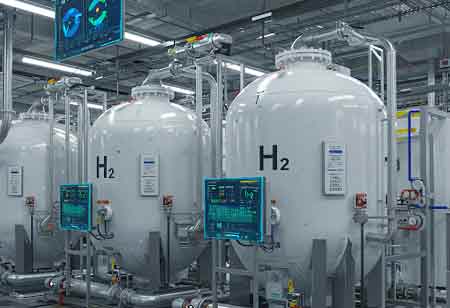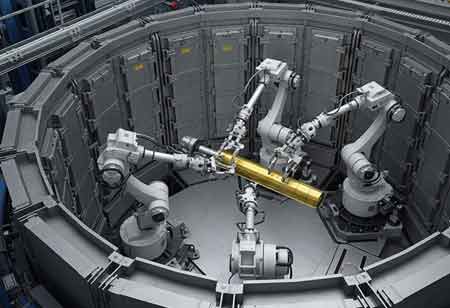CLOSE
Specials
I agree We use cookies on this website to enhance your user experience. By clicking any link on this page you are giving your consent for us to set cookies. More info
Be first to read the latest tech news, Industry Leader's Insights, and CIO interviews of medium and large enterprises exclusively from Energy Tech Review
Thank you for Subscribing
Liquid Hydrogen's Rise in Energy Infrastructure
The global energy transition demands innovative storage and transport of clean energy carriers. Liquid hydrogen (LH₂), distinguished by its high energy density by weight and potential for zero-emission applications, is emerging.

By
Energy Tech Review | Wednesday, April 30, 2025
Stay ahead of the industry with exclusive feature stories on the top companies, expert insights and the latest news delivered straight to your inbox. Subscribe today.
The global energy transition demands innovative storage and transport of clean energy carriers. Liquid hydrogen (LH₂), distinguished by its high energy density by weight and potential for zero-emission applications, is emerging as a key solution. However, storing hydrogen in liquid form requires maintaining cryogenic temperatures, introducing significant technological challenges. Advancements in liquid hydrogen storage technologies are accelerating, positioning them as essential enablers for the widespread adoption of hydrogen across transportation, industrial applications, and large-scale energy systems.
Advancements in Storage Tank Technologies
LH₂ storage tanks are complex engineering systems that maintain hydrogen in its cryogenic state. These tanks typically feature a double-walled construction, much like a large thermos flask. The inner vessel stores the liquid hydrogen, while the outer vessel provides structural integrity and houses insulation materials within the annular space. This space is generally maintained under high vacuum to minimize thermal conductivity and preserve the ultra-low temperatures required for LH₂ storage.
For small to medium-scale storage, such as laboratory environments, mobile systems, or early-phase refueling stations, tanks range from compact Dewar flasks to pressurized cryogenic tanks with capacities typically under 25 cubic meters. These tanks are designed with vacuum-jacketed insulation and often employ Multi-Layer Insulation (MLI), which consists of thin, reflective layers spaced within a vacuum to reduce radiative heat transfer. These applications' portability, modularity, and compatibility with refueling infrastructure are key design considerations.
Larger-scale LH₂ storage systems are used in industrial settings such as hydrogen production facilities, import/export terminals, and emerging grid-scale energy storage hubs. These tanks, often spherical or cylindrical, can hold several thousand cubic meters of LH₂. Built using decades of experience from aerospace and cryogenic industries, they employ sophisticated double-walled designs, high-performance vacuum systems, and advanced insulation technologies. While traditional insulation materials like perlite powder remain in use, newer designs adopt advanced alternatives to improve thermal efficiency and reduce hydrogen boil-off. The structural components must withstand considerable thermal stresses due to the stark temperature differential between ambient conditions and cryogenic contents, and thus must comply with rigorous safety standards such as the ASME Boiler and Pressure Vessel Code.
Innovations in Thermal Insulation
Thermal insulation plays a critical role in LH₂ storage efficiency, and significant technological advancements are being made in this area. Maintaining a high vacuum between the tank walls continues to be fundamental in limiting convective and conductive heat transfer. MLI remains a staple technology, with ongoing research into material improvements and optimized configurations. Alternative insulating media, such as evacuated hollow glass microspheres—also known as glass bubbles—are showing improved performance over traditional perlite, particularly in large-scale tanks. In applications where weight and space are critical, aerogels provide extremely low thermal conductivity and are being explored for specialized use. Furthermore, composite materials are being integrated into both structural and insulating components, offering promising benefits in weight reduction and thermal management.
Even with the most advanced insulation systems, some degree of heat ingress is unavoidable, vaporizing a portion of the stored LH₂, commonly called boil-off gas (BOG). Effective BOG management is essential to maintaining tank pressure and minimizing hydrogen loss. Pressure relief systems equipped with advanced proportional valves allow precise control over venting, enabling gradual and safe release of excess gas, which can often be redirected for recovery or reuse. Increasingly, BOG is being captured and utilized on-site, powering fuel cells or supporting other local operations. Another strategy involves reliquefaction systems, where cryogenic refrigeration units re-condense BOG back into liquid form, reducing net hydrogen losses. Integrated Refrigeration and Storage (IRAS) systems combine passive insulation with active cooling to deliver consistent pressure management and superior thermal performance. In pursuit of Zero Boil-Off (ZBO) storage, these systems seek to completely eliminate hydrogen loss by balancing heat ingress with active removal. Initially developed for space missions, ZBO technologies are gaining relevance for high-value or long-term terrestrial applications. Additional passive features, such as gas-cooled shields and control of the ortho-para hydrogen conversion, further contribute to minimizing boil-off.
As LH₂ storage becomes increasingly integrated into the broader hydrogen energy landscape, its role spans several critical sectors. In terms of bulk transport and distribution, the high energy density of LH₂ allows for efficient large-volume transportation over long distances using cryogenic tanker trucks and ships, making it a cornerstone of emerging global hydrogen supply chains. In transportation infrastructure, LH₂ storage underpins hydrogen refueling stations, particularly for heavy-duty vehicles like buses, trucks, trains, and eventually marine and aviation sectors, which require fast fueling and large fuel volumes. Industrial sectors such as chemical manufacturing, steel production, and refining are also turning to hydrogen as a clean alternative fuel and feedstock, necessitating robust and scalable LH₂ storage systems.
Materials and Safety Standards for LH₂ Storage
The design and construction of LH₂ storage systems demand materials that can endure cryogenic temperatures near 20 K while retaining structural integrity and resisting hydrogen embrittlement. This condition compromises metal ductility due to hydrogen diffusion. Austenitic stainless steels, specific aluminum alloys, and advanced composite materials are commonly employed for their reliability under such extreme conditions, with ongoing research focused on developing lighter, stronger, and more cost-effective alternatives. Equally critical are the stringent safety protocols governing the handling of LH₂, a highly flammable cryogenic substance. Industry standards—developed by bodies such as ASME, ISO, ATEX, and PED—cover essential elements including pressure relief systems, leak detection, material compatibility, hazardous area classification, and operational procedures. As LH₂ infrastructure expands into public applications like transportation and energy storage, continual evolution and harmonization of these materials and safety standards are vital to ensuring performance, reliability, and safety.
The liquid hydrogen storage is characterized by continuous innovation and increasing deployment. Advancements in thermal insulation materials and techniques and sophisticated BOG management strategies aiming towards zero boil-off are significantly improving storage efficiency. Parallel progress in materials science is enabling lighter and more robust tank designs. Market forecasts indicate steady growth, driven by the expanding hydrogen economy, particularly in heavy-duty transportation, industrial decarbonization, and the potential for grid-scale energy storage. As production scales up and technologies mature, LH2 storage solutions are poised to play an indispensable role in enabling hydrogen to fulfill its promise as a versatile and clean energy carrier for a sustainable future.

Copyright © 2025 Energy Tech Review. All rights reserved






